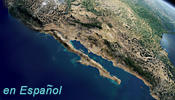![[Ocean Oasis Field Guide]](images/bnr-oo-field.gif)

![[Ocean Oasis Field Guide]](images/bnr-oo-field.gif) |  |
|
Populus tremuloides SALICACEAE (Willow Family) | |
|
The generic name refers to the Latin populus for a great number due to the number and continual motion of the leaves resembling crowds of people. The specific epithet refers to the Latin tremulus meaning quaking or trembling, reinforcing the fact that the leaves are constantly moving and creating sound even in the slightest breeze. DescriptionThe Quaking Aspen is a tree that grows 15 m (45 feet) high and has smooth white bark. The deciduous leaves are deep green and ovoid to triangular in shape 2-4 (7) cm (3/4 to 1-1/2 inch) that turn a golden-yellow in the fall. The flowers appear from April to June. Range and HabitatThis species grows in high mountain meadows of Baja California in the Sierra San Pedro Mártir, and north into the United States. This Aspen is not found in the Sierra Juárez or in San Diego County. Natural HistoryThe lateral roots of this tree give rise to new trees, so that groves appear as windrows. This form of asexual reproduction causes a number of forested areas to be covered by exact genetic duplicates of trees, even to the point of groups of trees having the same fall leaf color or timing of leaf color change different than surrounding groves. This tree often provides erosion control in heavily logged or burned areas and is closely related to Cottonwoods such as Populus fremontii. |


|
Text by Bob Lauri
Photographs: top by Jon Rebman, bottom by Reid Moran
Field Guide |
Site Index |
Ocean Oasis Introduction
|
|
© 2000 San Diego Natural History Museum |